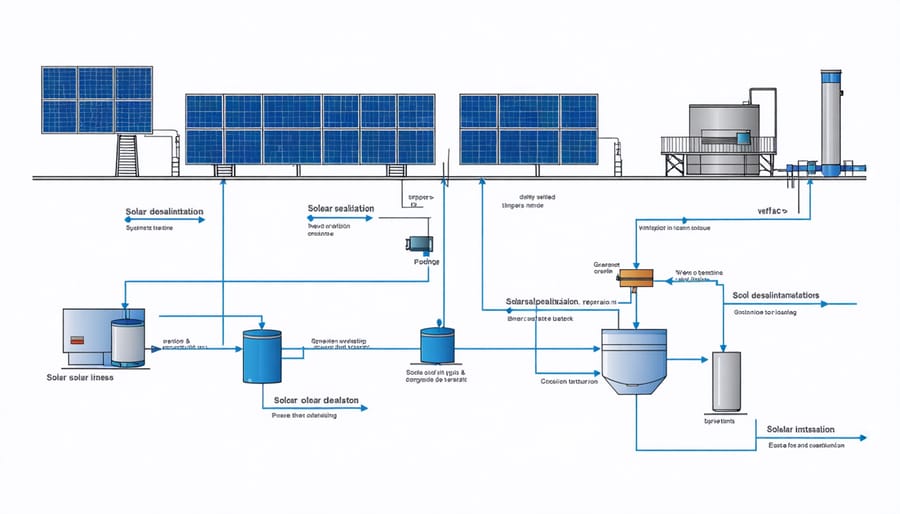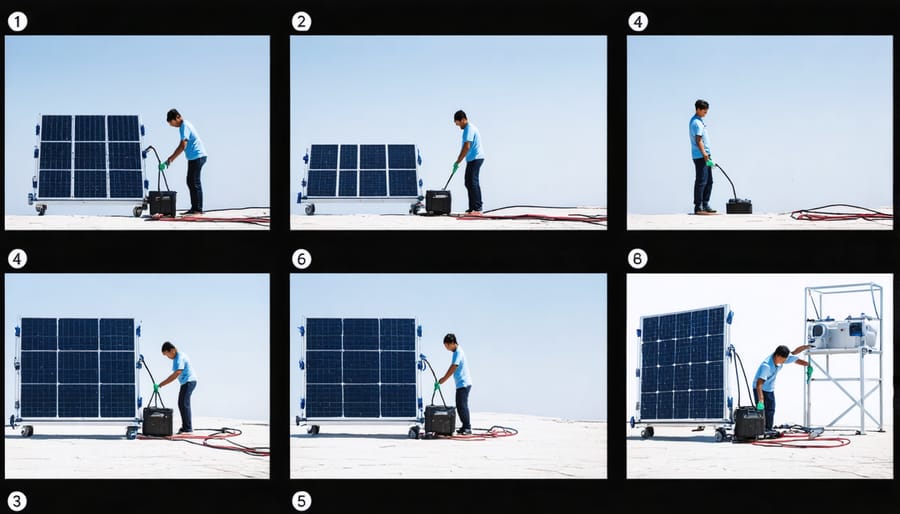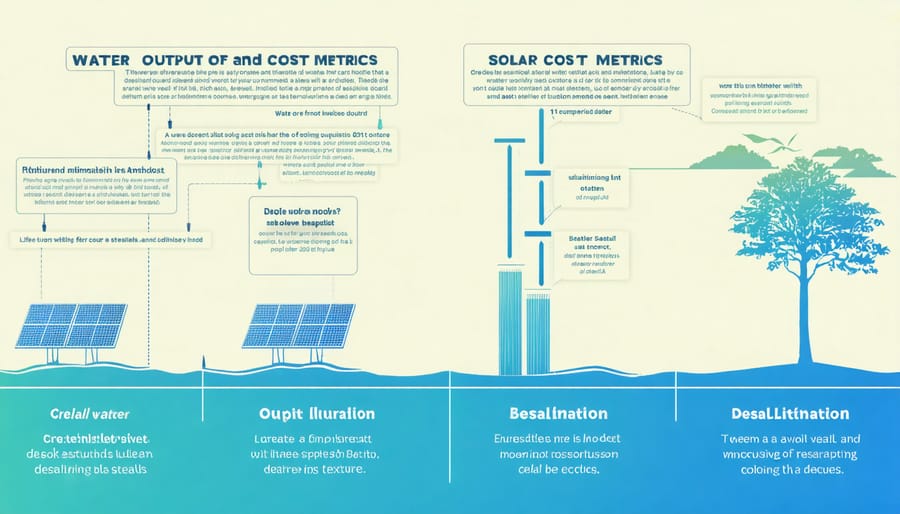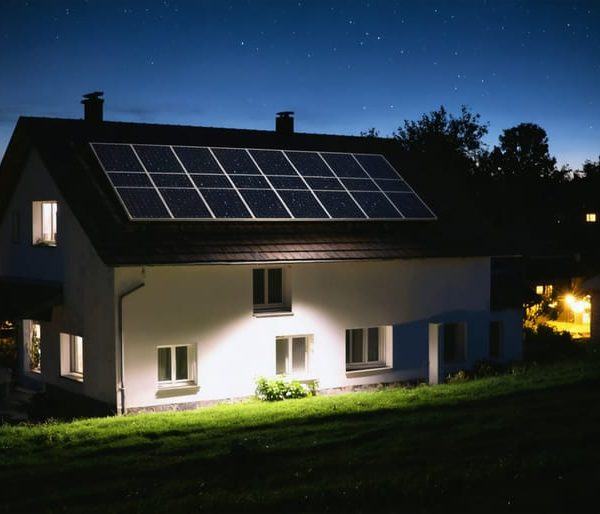Solar-Powered Emergency Water Purification: Your Lifeline When Disaster Strikes
Transform seawater into clean drinking water using innovative solar-powered desalination units – a breakthrough technology that’s revolutionizing water security in coastal regions and emergency situations. These portable systems, which seamlessly integrate with existing solar emergency power systems, harness the sun’s energy to produce up to 5 gallons of fresh water daily without requiring external power sources or complex infrastructure.
Unlike traditional desalination methods that consume massive amounts of electricity, solar-powered units operate silently and sustainably, making them ideal for disaster response, remote locations, and off-grid living. The technology combines advanced photovoltaic panels with efficient membrane distillation processes, delivering reliable access to clean water while eliminating the environmental impact of conventional desalination methods.
As climate change threatens water security worldwide, these innovative units represent a practical, sustainable solution for communities facing water scarcity challenges. Whether preparing for emergencies or seeking long-term water independence, solar-powered desalination offers a powerful tool for ensuring access to life’s most essential resource.
How Solar Desalination Works
The Science Behind Solar Desalination
Solar desalination works by harnessing the sun’s energy to replicate nature’s water cycle in a controlled environment. When sunlight hits the unit’s clear cover, it creates a greenhouse effect inside, heating the saltwater. As the water warms up, it begins to evaporate, leaving behind salt and other impurities. The pure water vapor rises and collects on the sloped glass or plastic cover.
Because the cover is angled, the condensed freshwater naturally flows down and collects in channels that direct it to a storage container. This process mirrors how the sun creates rain in nature, but in a much smaller, more efficient space. The black-colored basin absorbs more sunlight, making the process even more effective.
What makes this system so remarkable is its simplicity – there are no moving parts, no electricity needed, and minimal maintenance required. The only energy source needed is abundant, free sunlight, making it an ideal solution for both emergency situations and everyday use in areas where clean water is scarce.

Key Components of a Solar Desalination Unit
A solar desalination unit consists of five main components working together to transform saltwater into fresh drinking water. The solar collector, typically a dark-colored surface or panel, absorbs sunlight and converts it into heat energy. Below this sits the water basin, which holds the saltwater and allows it to warm up gradually. A clear glass or plastic cover slopes above the basin, creating a greenhouse effect while allowing condensation to form and slide downward. Collection troughs along the sides catch and channel the purified water into a storage container. Finally, the unit includes a filtered inlet for adding new saltwater and an outlet valve for removing concentrated brine. These parts work together in a simple but effective cycle: the sun heats the water, which evaporates, leaving salt behind, then condenses on the cover as pure, drinkable water.
Setting Up Your Emergency Solar Desalination Unit

Installation Steps
Setting up your solar-powered desalination unit can be accomplished in a few straightforward steps, similar to a basic DIY solar installation. Begin by selecting a sunny location with easy access to your water source. Clear the area of any debris and ensure the ground is level.
First, mount the solar panels on their support structure, angling them between 30-45 degrees for optimal sun exposure. Connect the panels to the charge controller using marine-grade wiring, making sure all connections are waterproof.
Next, position the water storage tanks. Install the pre-filter system between your source water intake and the main desalination unit. Connect the pump to both the power system and water lines, ensuring all fittings are properly sealed.
Set up the reverse osmosis membrane housing and connect it to both the intake and clean water storage tanks. Install the pressure gauges and monitoring systems according to the manufacturer’s guidelines.
Finally, test the system by running it for several hours, checking for leaks and monitoring water quality. Regular maintenance includes cleaning the solar panels monthly, replacing pre-filters every 3-6 months, and checking the reverse osmosis membrane annually.
Remember to keep detailed records of installation dates and maintenance schedules. For optimal performance, clean the system regularly and inspect all connections during seasonal changes.
Maintenance and Care
Regular maintenance of your solar-powered desalination unit is crucial for optimal performance and longevity. Start by cleaning the solar panels monthly using distilled water and a soft cloth to remove dust, salt spray, and debris. Avoid using harsh chemicals or abrasive materials that could scratch the panels’ surface.
Check the water filters every two weeks and replace them according to the manufacturer’s guidelines, typically every 3-6 months. Look for signs of clogging or discoloration, which indicate it’s time for a replacement. Keep spare filters on hand to ensure continuous operation.
Inspect all pipes and connections quarterly for leaks or corrosion, particularly in areas exposed to saltwater. Apply marine-grade anti-corrosion coating annually to protect metal components. Clean the collection basin monthly to prevent mineral buildup and algae growth.
Monitor the system’s performance through its digital display if available. A sudden drop in water production might indicate maintenance is needed. During winter months, drain the system if temperatures drop below freezing to prevent pipe damage.
Keep detailed maintenance records, including dates of filter changes and cleaning sessions. This helps track the system’s performance and anticipate when components need replacement. For coastal installations, increase cleaning frequency due to higher salt exposure.
Consider scheduling annual professional inspections to ensure all components are functioning correctly and to catch potential issues early. This preventive approach helps avoid costly repairs and system downtime.
Real-World Performance and Benefits
Water Output and Efficiency
A typical solar-powered desalination unit can produce between 3-5 gallons (11-19 liters) of fresh water per day, depending on sunlight availability and water salinity levels. This output is sufficient for a small family’s essential drinking and cooking needs during emergency situations.
The efficiency of these units varies with weather conditions and geographical location. On clear, sunny days, you can expect maximum output during peak sunlight hours (usually 10 AM to 4 PM). Production may decrease by 40-60% on cloudy days, so it’s important to plan accordingly and have water storage solutions in place.
For optimal performance, regular maintenance is crucial. Clean solar panels can improve efficiency by up to 25% compared to dusty or dirty ones. The desalination membranes typically operate at 30-45% efficiency, converting about one-third of saltwater input into freshwater output.
Many users report best results when combining their unit with a small storage tank, allowing them to accumulate excess production during sunny periods for use during less favorable conditions. This approach ensures a more consistent water supply throughout varying weather patterns.

Cost-Benefit Analysis
While the initial investment in a solar-powered desalination unit may seem substantial, ranging from $2,000 to $8,000 depending on capacity, the long-term benefits often outweigh the costs. When integrated with existing emergency solar power solutions, these units can provide significant savings on water costs while offering invaluable water security.
The average system pays for itself within 3-5 years through reduced water bills and eliminated bottled water expenses. For a typical household, this can translate to savings of $800-1,200 annually. Additionally, government incentives and tax credits for renewable energy installations can offset 20-30% of the initial setup costs.
Maintenance costs are relatively low, typically requiring only periodic filter changes and basic system checks. The solar panels themselves have a lifespan of 20-25 years, while the desalination components usually last 10-15 years with proper care. This durability, combined with rising water costs and increasing water scarcity concerns, makes solar desalination an increasingly attractive investment for both residential and commercial applications.
Emergency Preparedness Tips
Being prepared for emergencies means having reliable access to clean water, and a solar-powered desalination unit can be a game-changing addition to your emergency kit. Here’s how to effectively incorporate this technology into your preparedness strategy:
First, establish a dedicated space for your unit in an area that receives consistent sunlight throughout the day. Keep the solar panels clean and protected from debris, and consider installing a backup battery system to ensure operation during cloudy periods.
Store essential maintenance supplies nearby, including spare filters, cleaning materials, and basic tools. Create a laminated quick-start guide that family members can easily follow, and practice setting up the system regularly so everyone knows how to operate it in an emergency.
Monitor weather patterns and start your unit before a predicted emergency to build up a reserve of clean water. A good rule of thumb is to store at least one gallon per person per day for a minimum of three days. Use food-grade containers and rotate stored water every six months.
Keep a log of your unit’s performance and maintenance schedule. This helps you track efficiency and anticipate when components might need replacement. Consider having spare parts on hand for critical components that might be difficult to obtain during an emergency.
Remember that solar desalination works best as part of a comprehensive water strategy. Combine it with rainwater harvesting and water conservation practices. During non-emergency times, use the system regularly to ensure it stays in working order and to familiarize yourself with its operation.
Finally, connect with local emergency response groups and share knowledge about your system. Your solar desalination unit could become a valuable community resource during widespread water emergencies.
As we’ve explored throughout this article, solar-powered desalination units represent a crucial advancement in emergency preparedness and sustainable water solutions. These innovative systems provide a reliable backup water source when traditional infrastructure fails, offering peace of mind during natural disasters, power outages, or other emergency situations.
By harnessing the sun’s energy to transform saltwater into clean, drinkable water, these units offer independence from the grid while maintaining a zero-carbon footprint. Their ability to operate without external power makes them invaluable tools for coastal communities, remote locations, and anyone serious about emergency preparedness.
The combination of renewable energy and water purification technology not only addresses immediate emergency needs but also contributes to long-term sustainability goals. As climate change continues to impact our water resources and weather patterns become more unpredictable, having a solar-powered desalination unit ready can make the difference between crisis and resilience.
Whether you’re a homeowner looking to enhance your emergency preparations or a property manager seeking sustainable solutions, investing in solar desalination technology is a forward-thinking choice that ensures water security while supporting environmental stewardship.











